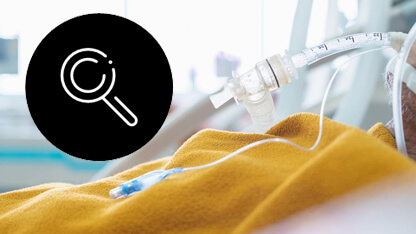ISO 10993-18 chemical characterisation of medical device materials, biocompatibility testing for medical devices including extractables leachables supporting identification and control of biological hazards from material constituents
The ISO 10993-18 chemical characterization of materials standard (Part 18 of the biological evaluation of medical devices guidance) provides a framework for medical device biocompatibility testing requirements to evaluate the chemical composition of medical device materials and, through extractables leachables testing, evaluate their potential to release leachable chemical substances and impurities which may present a health risk to a patient during the clinical conditions of use.
Whether you are a materials suppliers or manufacturers of medical devices, drug delivery systems or drug/device combination products, an important part of chemical characterisation requirements for biological evaluation is the identification of potential extractable substances released (under controlled extraction conditions) from the medical device materials or components. Robust data from controlled studies can support the equivalence of a proposed material to an established biocompatible material. The data from ISO 10993-18 biocompatibility testing and extractables studies can also be used to screen new materials to assess their safety and potential risks associated with leachable substances for a specific clinical application. When considering drug delivery systems, or combination products it is also likely that it will be necessary to demonstrate compliance to PRQI, FDA and ICH Guidelines. The data from chemical characterisation studies can inform the toxicological risk analysis in order to demonstrate biological safety.
The European Medical Device Regulation (EU MDR) came into force in 2021, bringing an increased focus on chemical characterization testing of medical devices including extractables and leachables. In addition, the EU MDR regulations highlight the need for identification of carcinogenic, mutagenic and reprotoxic (CMRs) substances in extractions from the medical device in control and mitigate potential release of hazardous CMR substances during intended clinical exposure.
Extractables and Leachables to Evaluate Chemical Release
A key part of the ISO 10993 Part 18 guideline are steps to determine extractables leachables from the medical device. An extraction study can be performed to identify and quantify extractables with the goal of an extraction is to produce an extractables profile that is as comprehensive as a device’s leachables' profile. Depending on device class, application scenario and contact time the extractables and leachables study requires careful design. The extraction conditions should be selected with consideration of the nature of use of the device and the “contact category” in mind. Recommended extraction conditions include exhaustive, exaggerated, or simulated use conditions. Harsh extraction conditions might be required depending on the application scenario however overly aggressive extractions conditions can lead to an altered extractables' profile. In depth experience in the design of these studies is required to ensure an appropriate study that can be scientifically justified.
The actual chemical release, according to the ISO 10993-18 standard, can be determined with a leachables study to obtain an accurate estimate of the actual release of leachable chemical substances. Actual or accelerated extraction conditions (e.g., using elevated temperature) should be used to target substances of concern as identified during the extractables study but may also require screening for additional leachables with analysis of the leachate using sensitive and selective methods, and the levels of target or screened leachables quantified.
Multiple analytical screening techniques should be utilized to cover all compound classes from volatile to non-volatile. Our Intertek laboratory testing team use liquid chromatography–mass spectrometry (LC–MS) analysis, addressing both semi and non-volatile organic compounds, gas chromatography-mass spectrometry (GC-MS/MS), and Headspace GC-MS to determine volatiles and semi-volatiles and inductively coupled plasma spectroscopy (ICP, ICP-MS) for elemental analysis.
Chemical Characterization of Medical Device Materials of Construction
Supplier data and raw material data can help build a picture of chemical composition; however, composition can vary during production processes or storage as the device or materials come into contact chemical substances such as processing aids, cleaning fluids, mould release agents, process contaminants and sterilization residues or undergo degradation. Biocompatibility iso 10993 characterisation studies should be focused on the identification and quantification of the materials of construction of the medical device and the chemical constituents in each material of construction (material composition) with a particular focus on screening and determination of CMR substances.
Toxicological Risk Assessment
A toxicity risk analysis is required for all marketed products. Data from the leachables studies can be reviewed in accordance with ISO 10993-17, Biological evaluation of medical devices — Part 17: Establishment of allowable limits for leachable substances. It might be possible to use known information and component supplier data to confirm minimal risk levels for transient or short-term contact devices. In the case of drug delivery systems, it is necessary to conform to ICH, PRQI and FDA Guidelines. After review of chemical and material data gathered, the Toxicological Risk Analysis (TRA) can be completed for submission to authorities. The TRA is conducted using allowable limits, Safety Concern Thresholds (SCT) and Analytical Evaluation Thresholds (AET).
An End-to-end Resource for Medical Device Biocompatibility Extractables Testing and Chemical Characterization According to ISO 10993-18
Our medical device ISO10993 chemical testing lab experts provide experienced study design and robust data to give you the confidence you need to demonstrate safety and biocompatibility of the materials and components in your device. From data collation and review, data gap review, science-led extractables and leachable studies and toxicological risk assessment, our biocompatibility testing lab team provide an end-to-end resource. We can help to ensure safety of your medical device materials and components across your device’s lifecycle, including development and screening of new materials, reprocessing, and sterilisation.
We apply our in-depth knowledge about potential contamination associated with medical device materials to evaluate, accurately, the risk of leachables for even the most complex of medical devices and combination products. Our team design and deliver robust analytical programs to support your data requirements for subsequent toxicological risk assessments or for submissions to the regulatory authorities. Expertise includes:
• Method development and validation.
• ISO 10993-18 materials characterisation
• Toxicological Risk Assessment
• Chemical Characterisation to ISO 18562
• Measurement of extractable and leachable materials from medical devices
• Extractable and leachables for pharmaceutical container closure systems
• In-use simulation studies
• Assessment of processing residuals
• Batch-to-batch verification of materials
• Support for new material or new supplier evaluation
• Particulate testing and analysis and particulate release studies
• USP Plastics and container testing
• Stability and ageing studies with controlled ICH storage conditions
• Verification of process changes to support production
Biocompatibility is a common term used to describe how compatible a material is with bodily tissues or fluids. Biocompatibility is often used in relation to the biological safety evaluation of medical device materials or components when exposed to bodily fluids or the body. Materials referred to as biocompatible are used in implantable medical devices or other devices that may come into contact with the body. These biomaterials are evaluated to determine if the produce an unwanted immunological response or leaching of substance deemed to present a toxicological risk to the patient.

